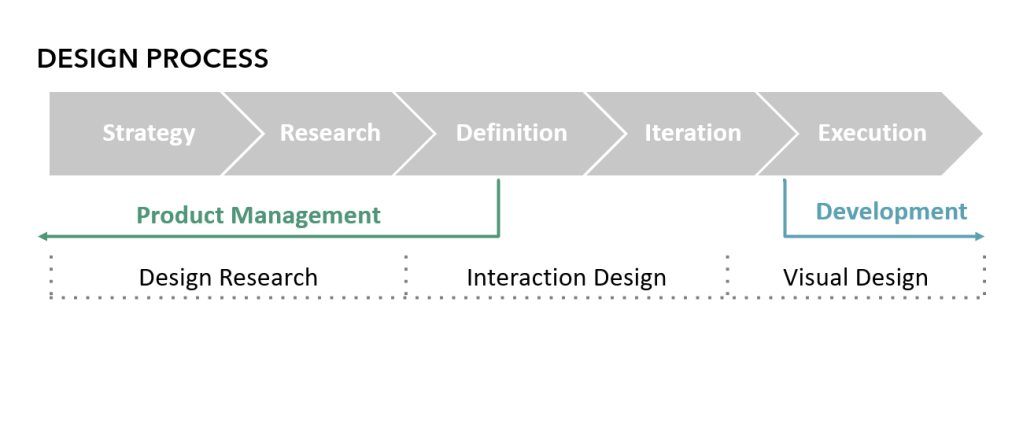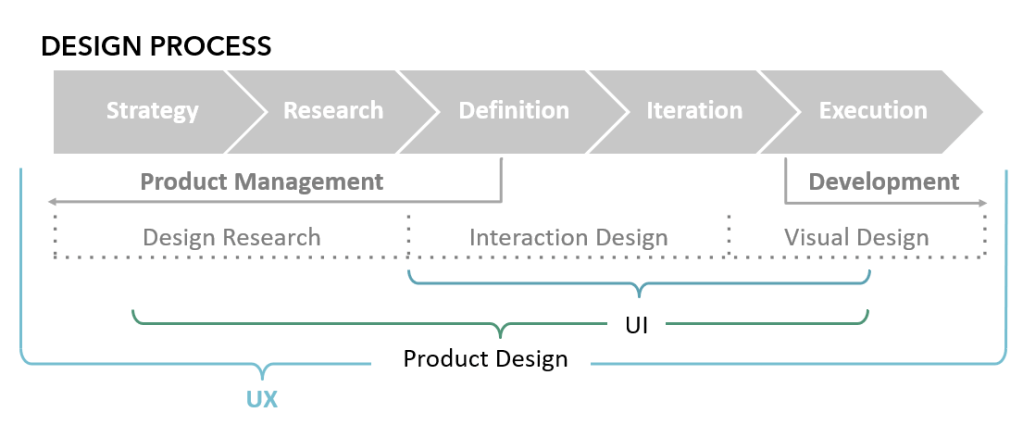TL;DR: Digital product design teams are often referred to as “the UX team” or “the UX/UI team,” which are terminologies that can significantly disturb a proper understanding of what UX and digital product design actually are and what a digital product design team does. For one, the user’s experience can’t be designed in the first place, and “doing UX” goes way beyond the scope of digital product design. For another, saying “UX/UI” isn’t meaningful since they’re neither the same nor separable concepts within a process; one can’t “do UI” without also “doing UX.” Generally speaking, digital product design covers design research, interaction design, and visual design, and it’s a much more accurate term for what’s commonly referred to as “UX” or “UX/UI.”
We believe a proper understanding of terminology is essential for being able to deliver one’s best possible work as a designer.
At BestSecret, the last Friday of the month is “Tech Day,” an all-day event full of learning and a nice opportunity to give talks, organize or participate in workshops, and learn from colleagues. At the most recent Tech Day, we—the digital product design team—took the chance to kick off a new series of talks and demos that we call the “Product Design Show & Tell.” That first Show & Tell we used to give a general introduction to what digital product design actually is and, in particular, why we consistently insist on being called “the product design team” and not “the UX team” or—even worse—“the UX/UI team” (sometimes also “UI/UX”).
We’re well aware that we’re not the first ones to write about this topic and we think it’s important to state that this article is not a “how we think it should be” or “how we think everyone should do it.” It’s simply a “the understanding we’ve come to.” We believe a proper understanding of terminology is essential for being able to deliver one’s best possible work as a designer. The following is a summary of what we found works well for our team over the last couple of months—for your inspiration.
What is digital product design?
When people ask us what this “digital product design” is that we’re doing, we usually like to refer to this article by Paul DeVay. He describes it as a spectrum that “can stretch from the early stages of business strategy and user research all the way to visual design and front-end implementation” and breaks it down into three more distinct parts: design research (also commonly referred to as user research or UX research), interaction design, and visual design.1

What constitutes digital product design—or the digital product designer—in a particular organization can vary, but it has to incorporate all three of those parts to some degree. For instance, as the digital product design team at BestSecret, we’re not so much involved in the business strategy and front-end implementation parts, but we do cover the rest of the process in close cooperation with product management and other teams. Paul DeVay writes: “You could say that the larger portion of this spectrum the design team is involved in, the more ‘design-minded’ that organization might be.”
However, if you’re doing only design research, you’re a design researcher, not a product designer; if you’re doing only interaction design, you’re an interaction designer, not a product designer; and—you guessed it—if you’re doing only visual design, you’re a visual designer, not a product designer.
Ultimately, it’s relatively simple: The design of an entire digital product requires research (i.e., understanding the users), designing the interactions, and designing the visuals, and you’re a digital product designer if you do all of that. Now, of course, unicorns aren’t real, which is why a digital product designer is a T-shaped professional, having strong expertise in one of the three, but to a lesser degree being able to take care of the remaining two as well.
Why don’t we like to be called “the UX(/UI) team”?
We believe it’s relatively clear to most people what’s being meant when one says “UX/UI” (or is it?); and yes, naturally it’s not the end of the world when we’re being called a “UX team” or “UX/UI team”.2 Also, this discussion is probably as old as digital product design itself and there’s a good chance many people are really tired of it. However, language and semantics do matter and we believe that this terminology has (subconscious) implications that can be really problematic when it comes to a proper understanding of what UX and design actually are.
1) Why we’re not a “UX team”
TL;DR: Because strictly speaking, the user’s experience cannot be designed, and responsibility for a good user experience goes way beyond a digital design team.
In his excellent book, Experience Required, Robert Hoekman, Jr., writes:
“A user’s experience can’t be designed. No matter how good you are at planning an intended outcome, an experience is far too complex, nuanced, subjective, and personal to be planned. The experience belongs to the user. No one else.”
In other words: UX happens in the user’s head, and how are we supposed to design something that is in someone else’s head? We can merely try to influence one’s experience through the digital product, including its UI, and the corresponding interactions, which we can actually design.

Hence, from a theoretical perspective, saying “UX design” doesn’t make a lot of sense in the first place.
Moreover, influencing the user’s experience goes far beyond a digital product design team. Achieving a good UX begins with business decisions at the highest level and doesn’t stop after a visual design has been completed and handed over to engineering. For instance, if management decides for a business model that makes the use of dark patterns inevitable, a digital product design team can of course design those dark patterns very cleverly and appealingly. But that only means you have a clever, good-looking design, not a good UX. Another example is website performance, which can have a massive impact on the user’s experience, but is definitely more of an engineering than product design topic (which, of course, doesn’t mean it’s exclusively an engineering topic).
If you equal “digital product design team” with “UX team,” you ultimately imply that digital product designers are more or less fully responsible for the UX. This, in turn, means that anything else doesn’t matter as much. No problem in simply prioritizing the features the HiPPO finds most important for implementation—as long as they’re well designed we’ll have a good UX, right? Unfortunately, it doesn’t work like that.
Everyone who—in whatever capacity—directly or indirectly contributes to a digital product “does UX,” not just a digital product design team. Some might influence UX more than others, yes, but everyone contributes.
2) Why “UX/UI” is a problematic term
TL;DR: Because the slash implies one of two: Either (1) UX and UI are the same, or (2) UX and UI are separable things in the sense that you can somehow “do UI” without “doing UX.” Both are wrong.
Saying “UX/UI” is wrong on many levels. What is the slash supposed to mean? That they’re the same? Or that they’re somehow separable and that there are people who “do UX” and people who “do UI”, but not the other thing, respectively, and that when you “do UX/UI” you do all of it?
The first one is relatively easy. They’re clearly not the same, because they’re completely different things in themselves. As we’ve seen in Fig. 2 above, the UI is “in the computer” while the UX is “in the user’s head.” So, how can they be the same? A user interface is a prerequisite for the user’s experience and we can influence UX through the UI we design, but you can clearly not say UI = UX.
That leaves us with the second possible interpretation: UX and UI are separable things. This is in line with the common understanding we have mostly encountered in our many, many years in industry, i.e., “UX” and “UI” are two parts of a process, and “UX” generally happens before “UI.”

In other words, if you “do UX,” you take care of research, ideation, and rough concepts and wireframes; and if you “do UI,” you do mockups, hi-fi prototypes, and visual design. Some also consider that “doing UI” starts with the first concepts and wireframes, which means “doing UX” is basically research.
And yes, in that sense, we are a UX/UI team because we do all of the above. But again, the terminology has problematic implications. It communicates not only that UX is the sole responsibility of a digital product design team, but also that it is only a fraction of what we do. However, we’ve already established that “doing UX” goes far beyond digital product design, and “doing UI” without “doing UX” is simply not possible (cf. Fig. 2).
If you want to consider “UI” in the narrowest possible sense, you could say it starts with the first idea for an actual interface and ends when a visual design is handed over to engineering. That covers all of what digital product design is, minus design research. So, if you desperately want to use a slash-notation for what a digital product design team does, please at least say “Research/UI”, not “UX/UI”.
Conclusions
We’re often referred to as a “UX team” or “UX/UI team”, even though we’re doing digital product design. We believe that the whole “UX(/UI)” terminology has some problematic implications that disturb perceptions of what digital product design is.
For one, the UX is the result of interactions with a digital product and happens “in the user’s head.” We can’t design a UX. We can merely influence it through the digital product we design. Moreover, UX goes beyond digital product design alone. Everyone who contributes—directly or indirectly—to a digital product “does UX.” It’s a vast cross-functional effort.
For another, “UX/UI” implies that UX and UI are either the same, or that they’re separable concepts. However, “UX” is not merely part of a process (see above), and it is impossible to “do UI” without also “doing UX”.
Ultimately, we want to conclude with our personal understanding of this whole terminology craze, and we hope you agree, or at least feel inspired to reassess your mental model.

☕☕☕
I love coffee, and if you want to support my work, you can always spend me one, or subscribe to my newsletter.
Acknowledgments
This article was a team effort. Thank you, Bianca Mueller, Karolina Truong, Sebastian Zorn, Guido Wehrmann, and Sebastian Sohl-Dang! Also, thanks to Pia D’Ascanio, Daniela Högerl, and Martin Schmitz for their support.
Footnotes
1 It’s important to note that, of course, these three are not perfectly distinct, but do significantly overlap. We’d like to refer the interested reader to Alan Cooper’s About Face, the “bible of digital product design,” for more detail. For the sake of simplicity, however, we treat design research, interaction design, and visual design as quite distinct here.
2 And, honestly, you’re going to be more successful on LinkedIn when you’re a “UX/UI designer” than when you’re a “Product Designer”. Then again, LinkedIn is probably not the gold standard when it comes to correct terminology and semantics.
